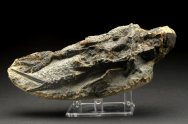|  Description:
Offered is a superbly preserved dorsal-side 3D lobster from the
Cretaceous of Montana. It is a male specimen as evident by the large
right side crusher claw. Both arms and claws are fully extended,
inflated and almost completely intact. The eyestalks are potntially
in place. Note the pustulate carapace and arms. This one even has
its walking legs preserved! The telson is tucked under, but was
masterfully prepped out. The abdomen and telson show little compression.
However, there is some crushing to the top left hand side of the
abdomen. The thorax and head have incurred some substantial crushing. Description:
Offered is a superbly preserved dorsal-side 3D lobster from the
Cretaceous of Montana. It is a male specimen as evident by the large
right side crusher claw. Both arms and claws are fully extended,
inflated and almost completely intact. The eyestalks are potntially
in place. Note the pustulate carapace and arms. This one even has
its walking legs preserved! The telson is tucked under, but was
masterfully prepped out. The abdomen and telson show little compression.
However, there is some crushing to the top left hand side of the
abdomen. The thorax and head have incurred some substantial crushing.
This
Paleonephrops browni is from an old collection. The site is now
closed to all collecting. It is quite doubtful you will ever find
another available in the future. My talented master preparator Rod
Bartlett just recently completed the air abrasion work. Rod specializes
in crustacean preparation. He painstakingly invested over thirty
hours of work into curating this specimen. This magnificent specimen
truly earns our highest accolade of museum fossil.
Background:
Only a few of these specimens have been preserved in this state
of preservation. This species is found in the same areas as the
more famous and numerous iridescent ammolite ammonites Placenticeras.
Those rare lobsters discovered normally shatter when the concretion
is broken, or are in a poor state of preservation. According to
the previous owner, this one was obtained from a small research
collection, of which, the rest went to a university for study. For
comparison sake, consider this the crustacean discovery equivalent
of a fully complete T-rex skeleton
The
lobsters are preserved in argillaceous limestone concretions that
have the shape of slightly flattened prolate ellipsoids. The concretions
that contain lobsters generally contain only a single animal. However,
a few contain two lobsters, and one contained a lobster and a crab.
The lobsters are preserved as sediment filled exoskeletons which
usually have the claws, cephalothorax and abdomen articulated, preserved
in an upright position and stretched out along the axis of the animal.
The abdomen may be enrolled to varying degrees. Most specimens show
some evidence of minor dorsal-ventral compression and a few are
laterally compressed. Diagenetic changes have altered the chitinous
exoskeletons although preservation is delicate enough to have preserved
internal (endophragmal) skeletons in some individuals. The lobster
corpses and molts decayed on the sea bottom and as the articulating
membranes decomposed the surrounding sediment found its way into
the interior of the exoskeleton. Calcite precipitated and filled
the interstitial spaces in the mud in and around the lobsters forming
the argillaceous limestone concretions. (From the Journal of Paleontology,
November 1977, Robert F. Feldman). |